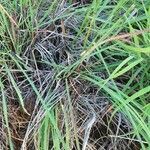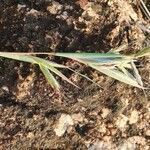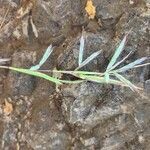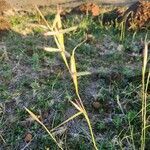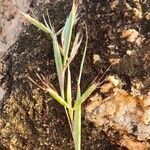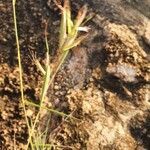Caespitose perennial, arising from short scaly rhizomes; culms 60–200 cm. high.. Leaf-blades up to 30 cm. long, 4 mm. wide.. False panicle 30–80 cm. long, its branches slender and graceful; spatheoles linear to almost filiform, 4.5–5.5 cm. long, the peduncles ± as long; racemes 10–12 mm. long, 2–4-awned per pair, delicate, not deflexed; raceme-bases very unequal, the upper (4–)4.5–8(–10) mm. long, slender, glabrous.. Homogamous pairs 1 at the base of the lower raceme, and 2 at the base of the upper.. Sessile spikelet 5.5–7 mm. long, glabrous to villous with white hairs; callus 1.8–3 mm. long, pungent; awn 3–5.5 cm. long, hirtellous with fulvous hairs 0.7–1.2 mm. long.. Pedicelled spikelet with an awnlet 1–5 mm. long.
False panicle 30–80 cm long, virgate, its branches slender and graceful; spatheoles 4.5–5.5 cm long, linear to almost filiform; peduncles about as long as the spatheoles, very fine and flexuous, with or without spreading white hairs above; racemes 10–12 mm long, 2–4-awned per pair, delicate, yellowish-green often tinged with violet, terminally exserted, not deflexed; raceme-bases very unequal, the superior (4)4.5–8(10) mm long, slender, glabrous.
Sessile spikelets 5.5–7 mm long; callus 1.8–3 mm long, pungent; inferior glume linear-oblong, flat on the back or with the inner nerves ± raised towards the apex and with an indistinct median hollow towards the base, glabrous to villous with white hairs; awn 3–5.5 cm long, the column hirtellous with fulvous hairs 0.7–1.2 mm long.
Homogamous spikelets 5–7 mm long, linear-lanceolate, glabrous, a single pair at the base of the inferior raceme and 2 pairs at the base of the superior.
Pedicelled spikelets 5–6 mm long, linear-lanceolate, terminating in an awnlet 1–5 mm long; callus absent; pedicel-tooth very short, triangular.
Caespitose perennial arising from short scaly rhizomes; culms up to 200 cm high, branched from the inferior nodes.
Leaf sheaths glabrous or rarely sparsely pilose with stiff white hairs; leaf laminas up to 30 cm × 4 mm.
Caespitose with culms 0·6–2 m. high
